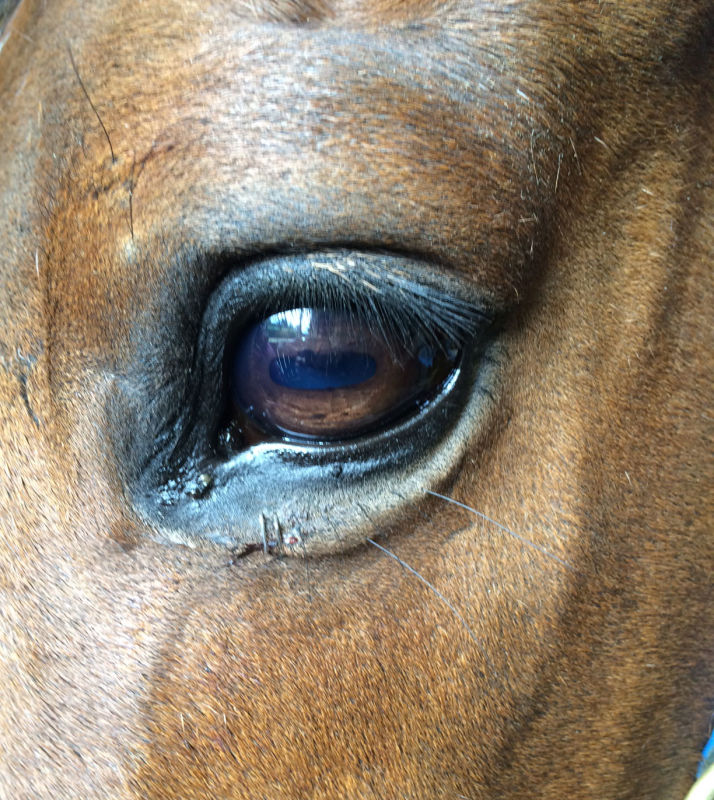Equine Conjunctivitis

Conjunctivitis is inflammation of the conjunctiva; the clear thin membrane coating the sclera (white part of the eye) and the underside of the eyelids. The conjunctiva has many important roles including: lubrication, protection, and the supply of nutrients to the eye. Failure to recognize and treat conjunctivitis often leads to further problems arising and can potentially lead to blindness in some cases.
Some common signs of conjunctivitis include the affected eye showing:
- Discharge (clear, yellow, or with mucus)
- Swelling
- Reddening
- Squinting
There are many causes of conjunctivitis, which can either be primary or secondary. Primary causes are diseases or problems acting directly on the conjunctiva and can include diseases due to bacteria, viruses, allergies, parasites, and foreign bodies. Secondary causes are ones which initially affect another part of the eye or horse, but then go on to affect the conjunctiva. Secondary causes can include corneal ulcers, uveitis, upper respiratory infections, blocked nasolacrimal ducts, and glaucoma.
The most common causes of conjunctivitis seen in New Zealand horses include:
Equine Herpes Virus (EHV)
There are three strains of equine herpes virus present in New Zealand: EHV-1, EHV-2, and EHV-4. EHV-2 is found to be present in most horses in New Zealand and is therefore not strongly associated with disease. However, EHV-1 and EHV-4 can both cause upper respiratory tract infections and can lead to the development of conjunctivitis. In these cases, multiple horses are commonly affected, and horses often present with additional respiratory disease signs such as lethargy, coughing, nasal discharge and an increased effort to breathe.
Corneal Ulcers
Ulceration of the cornea is due to damage of one or more of the corneal layers. This is often extremely painful for a horse and can commonly lead to secondary conjunctivitis due to excessive rubbing of the eye. Corneal ulceration is most commonly due to trauma where affected horses typically show signs of squinting, discharge from the eye, and reddening of the eye. Typically, only one horse is affected due to the initial problem being a non-infectious cause and diagnosis is made with the aid of fluorescein dye. The dye is applied to the surface of the eye and any ulceration/damage causes the dye to be absorbed in that area, producing a fluorescent patch of colour.
Uveitis
Inflammation of the structures within the eye can secondarily lead to conjunctivitis. Like corneal ulcers this disease can be extremely painful for a horse and can cause them to show signs such as squinting, tearing, reddening, and clouding of the eye. Uveitis is the most common cause of blindness in horses, meaning it is very important to have prompt veterinarian treatment.
Diagnosing conjunctivitis is based predominately on the animal’s history and clinical exam findings. Conjunctivitis can be caused by a multitude of processes, meaning a full physical and eye examination is needed. External examination of the eye often includes close inspection of the eye surface, eyelids, and applying fluorescein dye. Internal examination of the eye is evaluated using an ophthalmoscope to assess structures such as the lens and retina, which provides further information for determining the cause and severity of the disease.
The treatment of conjunctivitis varies depending on the cause, however in most cases lubricating the eye, anti-inflammatories, and often antibiotics are part of the treatment plan. Eye medication often needs to be applied to the surface of the eye at least three times a day in order to get on top of inflammation and/or infection. If conjunctivitis is not treated early or the recommended treatment protocol is not followed, the affected eye may progress to have serious non-reversible changes which may include blindness or the need for the eye to be removed.
by Stephanie Collins
Published Friday 26th of July 2019